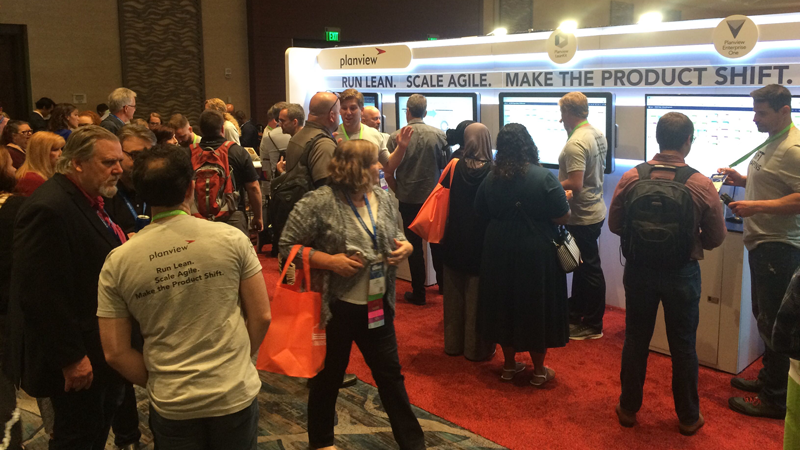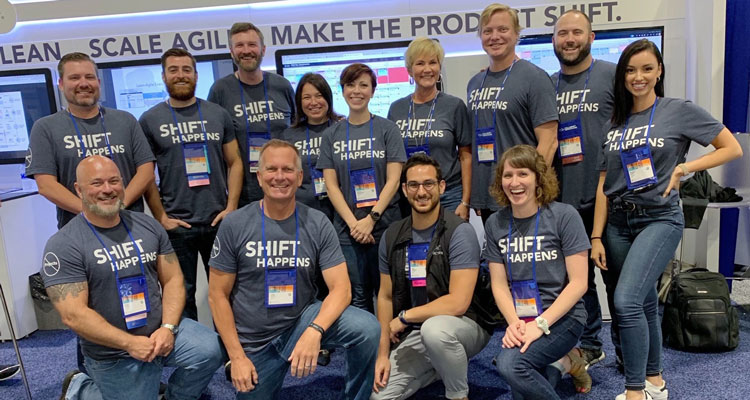
Last week, I attended the 2019 Global SAFe® Summit with my Planview family. We (Planview) got to reveal our new brand identity one day into the event, an unveiling that was met with an overwhelmingly positive reaction.
Going into the conference with this excitement, I also carried the perspective and outlook of both a Value Stream owner supporting an Agile transformation in a business function (marketing) and an employee of a vendor helping companies transform strategy to delivery in the changing world of work. For this reason, I furiously took notes during the reveal of SAFe 5.0—notes that I would like to share with you.
5 Key Takeaways from the 2019 Global SAFe Summit
To begin, I’d like to mention that, over the last several years, I’ve been a part of several Agile transformations, specifically within marketing and sales. I experienced the difficulty in trying to implement SAFe with its historical and heavy focus on software development and IT—roles, responsibilities, lingo, etc. However, SAFe 5.0 starts to remedy this issue.
1. SAFe 5.0 better supports Lean and Agile practices.
Characterized as the “operating system for business agility,” SAFe 5.0 carries enhancements that support Lean and Agile practices to continually and proactively deliver innovative business solutions faster than the competition. Agile team members are no longer just labeled as Product Owners, Scrum Masters, or Developers. Now, Agile Teams (of all types) hold just two specialty roles—Product Owners and Scrum Masters. The rest of the team can be comprised of people from Business, Dev, Ops, or Support functions. While subtle, this distinction in labels within Agile Teams will help eliminate some of the adoption barriers I’ve seen exist outside of Dev…because not every Agile team has “Developers”.

2. There is an increased emphasis on Lean-Agile leadership—embrace it.
SAFe 5.0 creates two new competencies of Business Agility—Organization Agility and Continuous Learning Culture. The increased emphasis on Lean-Agile Leadership—leading by example, modeling behavior, aligning mindset, words and actions to Lean-Agile values, and actively leading the change while guiding others to the new ways of working—is so critical and often under-appreciated by executives wanting to ‘do Agile’ vs truly ‘being Agile’.
In my experience, leaders often don’t build the case for “why change,” nor do they invest appropriate efforts into their own change. There are changes required for leaders to inspire and lead a truly successful transformation. If you’re a leader—I cannot stress this enough—educate yourself and embrace these qualities.
3. Develop a shared definition of ‘done’ and ‘quality.’
This one may require some explanation. The SAFe Summit offered many dedicated sessions around business functions (i.e. Marketing) using Lean-Agile approaches to improve business impact. In one particular session, delivered by a marketing leader, it was advised to develop a shared definition of ‘done’ and ‘quality.’ Why? This prevents a ‘reviewer bottleneck’ by leaders/CMOs, which can happen even in an Agile model. This shared definition, or checklist, balances the need for Minimal Viable Product (MVP) delivery and iteration, with a need for a basic quality check and experience.
4. It’s all about Kanban or Scrumban, not Scrum.
As Business Agility gains attention, so too does the use of Kanban or Scrumban (over Scrum) as the preferred Agile “sub-discipline” for business teams. In breakouts and discussions around Agile in business functions, there’s an increased acceptance that these are the preferred approaches, as they are more reflective of the nature of work and deliverables in non-development organizations. From my personal Agile Transformation experiences, I wholeheartedly agree.
5. Last, but certainly not least, shift is still happening.
This last point is still clear—shift is still happening. Sound familiar? I also covered this following the Agile 2019 conference (also noting the popularity of a good “shift happens” t-shirt). However, in this instance, making the shift from Projects to Products was emphasized in Dean Leffingwell’s opening keynote then further reinforced in the closing keynote by Dr. Mik Kersten from Tasktop.
From Dr. Kersten’s keynote, I’d like to share some of his assertions:
- Enterprises must get business and technical leaders aligned. The inability for business people to relate to the technical organization creates a perfect opportunity for spectacular failure.
- The business doesn’t see the trade-off of technical debt and feature work. If they don’t figure this out, they could be facing near (organizational) death experiences. To get there, measure flow metrics based on value streams. Stop focusing so much on the team-level metrics. Measure higher.
- Products embody the value delivery to the customer—not projects. Companies need to re-orient their teams and work to center on delivering value to customers.
Taking it down a level, we also had many conversations at the Planview booth with people struggling to scale Agile beyond the teams of teams into the portfolio layer of the business.
Delivery Managers and Transformation Consultants are having trouble coordinating cross-team dependencies, visualizing all the work, and communicating the delivery timing and business impact of those teams or teams-of-teams. They know delivery is happening faster with Agile, but they aren’t convinced it’s always the right things delivered. This same group of people is also trying to mesh Agile with their strategy while trying to figure out how to cost and capitalize Agile work appropriately—without the timesheet tax.
Quite frankly, this is where the right solution makes all the difference. Many team level tools make it nearly impossible to see all the work and connect that work to organizational goals and objectives. Without clear insight top to bottom and then connecting all Agile work (or non-Agile work, to be honest) bottom to top, an organization’s Agile transformation is only successful at the surface. Dig a little deeper, and you’re stuck just guessing how things are delivering against the bottom line.
Ultimately, I think the addition of Business Agility to SAFe 5.0 allows organizations to truly embrace a transformation and connects the entire business, not just software development and IT. I know they’ll continue to iterate and build this out, but well done, framework creators.
If you’re looking for more on SAFe 5.0 and how your organization can make the project to product shift, join Dean Leffingwell, Chief Methodologist and creator of SAFe, and Jon Terry, Chief Evangelist, Lean-Agile Strategy at Planview, in our upcoming webinar.




